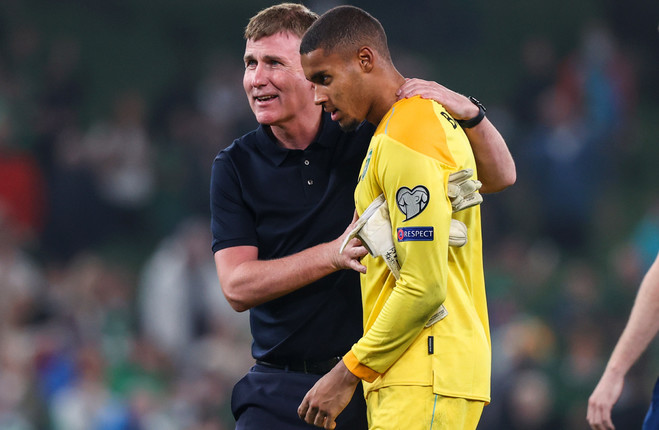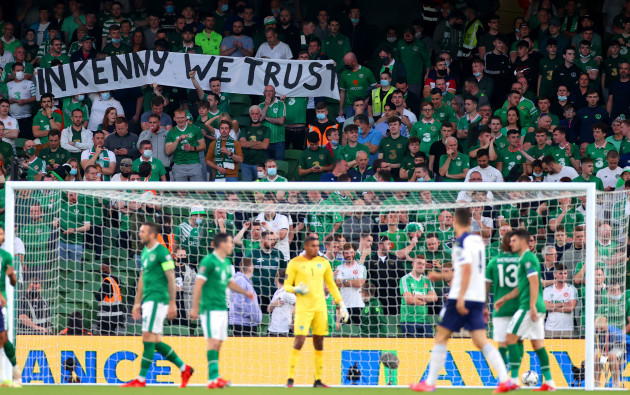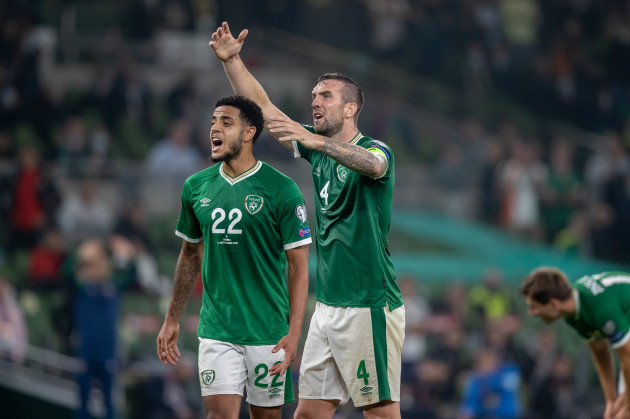PERHAPS WE WERE only ever happy amid the slough of heartbreak against Portugal, for then we were at least in peace: united in awe at Ronaldo and grievance toward the Slovenian referee, Mr. Jug.
But Mr. Jug could broker only a temporary ceasefire, and a couple of 1-1 draws at home reignited the infernal warring around Stephen Kenny.
It is incredible that the dominant conversation around the national team is whether you’re In Kenny We Trust or #KennyOut, at a time that the team is undergoing a near-unprecedented change in players, style, and pathways as a new-look Association clambers out of near-bankruptcy.
And yet here we are, once again getting high on the hire-and-fire cycle like the addicts we are.
Happily, this time, the FAI do not appear to be of a mind to be swayed by the debate.
Contrary to a couple of newspaper reports, Kenny’s job was not under threat if he had lost to Serbia. There have been no board discussions about his future this week and the plan remains that his position will be assessed at the end of the qualification campaign in November.
Results will, of course, form part of that review, as will a range of other issues including his standing among the players, the development of younger players, and any potential commercial impact of continuing with Kenny in the role.
The more relevant part of the commercial aspect should be his team’s ability to sell tickets to the remaining home games of the year – a friendly against Qatar and a qualifier against Portugal – but linking his teams’ current results to the FAI’s ongoing search for a primary sponsor would be disingenuous.
The new FAI are clearly inching out of the mire left by the John Delaney years – the recent equal pay deal an obvious sign of progress – but perceptions have lingered. For the second year running, the FAI have ranked 100 out of 100 in RepTrak’s rating of corporate reputations among the Irish public.(Irish Water are closest to the FAI; the GAA are 66th and the IRFU 29th.)
You have likely read about misgivings about Kenny among board members, and they do exist: the board is made up of individuals with their own opinions and, these days, are free to share them at meetings. This board does not always present a monolithic view, unlike the deferential blazers who once surrounded John Delaney.
But a full, detailed board discussion and decision on whether Kenny should get a new contract won’t be held until the qualification campaign is over in November.
Kenny certainly seems to have the backing of his players. There have been no troublesome leaks from the camp since the videogate farrago almost a year ago, while Matt Doherty shared his confidence in the manager with Tony O’Donoghue last night.
“We’ve always believed in what Stephen is trying to do. We get coached brilliantly with Anthony Barry and Keith Andrews, all the backroom staff, we’ve no complaints at all. The game plans they set us up with are really good.
“If you saw what they were doing with us on the training pitch, then people would really understand where we’re trying to go.”
So where are they going?
Ireland’s ongoing deficiencies in midfield mean they are largely building their attacks down the wing, and that was the plan last Saturday.
Aaron Connolly was to the left of the front three, but he pulled right out to the touchline, with James McClean tucked in behind him. Troy Parrott, to the right of the front three, moved centrally alongside Adam Idah, to create space down Ireland’s right-hand channel for Doherty and Coleman, largely exploited by John Egan’s raking, cross-field passes.
The plan seemed to be working, as Ireland created three goalscoring chances in the first 10 minutes, all down the right-wing. But Ireland then stopped doing it, and the turning point seemed to be the moment Azerbaijan cut easily through the midfield duo of Cullen and Molumby, which is a worryingly recurring trend under Kenny so far.
After that, Ireland never fully regained their rhythm, which James McClean later put down to confidence, rather than energy. When Makhmudov was given far too much space to score Azerbaijan’s opening goal, Stephen Kenny reflected his side’s fatalism by describing it as a “killer blow”.
Ireland panicked and chased the game by largely abandoning the plan of the first-half, and while they nicked a late equaliser against exhausted opponents, their frenzied strategy of slinging crosses into the box was less effective. Ireland have been averaging 17 crosses a game under Kenny; they took 30 in that second half alone.
According to WyScout’s Expected Goal (xG) metrics, Ireland’s three best chances all came in the first half, and all from down Ireland’s right wing, so it suggests Ireland were being reasonably effective and then became less effective.
In the context of that lack of confidence, you wonder how potentially transformative the break of pure, abnormal fortune against Serbia could prove to be.
While failing to beat Azerbaijan should not be blithely accepted as the cost of doing business these days, it’s true to say Ireland have been struggling to break down lower-ranked sides for years.
The only sides Ireland have beaten at home in competitive games since Robbie Keane retired in 2016 have been Georgia twice, Moldova, and Gibraltar, and none of them by more than two goals. (Plus, stats show Ireland were relatively unlucky to concede against Azerbaijan: of those opponents, only Gibraltar had fewer shots and a worse xG figure at the Aviva than Azerbaijan.)
But if Kenny got his set-up right, he got some of those in it wrong.
That Parrott and Molumby were replaced by McGrath and Hendrick for the Serbia game seemed a tacit admission so, but most surprising was the selection of Connolly. Kenny himself said the big learning of the Luxembourg defeat was that players not playing at club level struggled to reach the intensity of a second game in four days, but Connolly was picked to start again in spite of playing all of 45 minutes of club football this season.
Then again, Kenny’s trust in youth paid off handsomely against Serbia, as his two best performers were the teenagers.
Andrew Omobamidele’s selection is firmly to Kenny’s credit. Would another Irish manager have selected him ahead of a Premier League veteran like Ciaran Clark?
Gavin Bazunu most obviously kept Ireland in the game by saving nine of the 10 shots he faced, but he also made Ireland relevant in the game with his distribution.
Shane Duffy’s sloppy touch in his own box in the fifth minute summed up Ireland’s initial unease when passing in front of the Serbian press, but his accurate, longer-distance passes to the Irish wing-backs gave Serbia something else to worry about and Duffy and co. some more room to breathe.
In this respect, Ireland are profiting from simply using their goalkeeper more.
They desperately struggled to break the Luxembourg press on Bazunu’s debut, and didn’t use his distribution often enough, passing to him just 10 times. Yesterday Bazunu received 28 passes…and misplaced just two of his own.
There have been a few heart-stopping moments in Ireland’s efforts to build from the back under Kenny, but based on the evidence so far, it is working pretty well. Ireland lack the craft to cut open defences higher up the pitch, so they need to create space in which to play.
They did that many times against Serbia, usually finding McClean on the left, whose crosses were much better than on Saturday, though went totally unrewarded. Ireland are clearly coached to form patterns to beat an opponent press – big progress from the Luxembourg debacle – but they are still desperately lacking a threat in central attacking areas.
Ireland have improved in playing around opponents and getting to the final third, but against Serbia, they struggled to make anything happen once they got there, relying last night on a comedy own-goal to equalise without creating a chance of note beyond Omobamidele’s long-range pile-driver.
Ireland had just five touches in the opposition box against Serbia, the lowest figure they’ve recorded since the friendly shellacking against England last year.
That Ireland had to rely on such an outstanding display by Bazunu has been portrayed as a failure, but keep in mind the quality of the side they faced last night: Aleksander Mitrovic was the top scorer across all qualifying groups going into last night’s game, while Dusan Tadic led the way in assists.
Ireland remain a side stuck in progress, still held back by some of their old failings and still redeemed by some of their old strengths. We’ve seen good and bad from them over this window, just as we saw in March.
In a fraught and polarised debate, the accurate picture lies somewhere in the middle.
It’s for the FAI to pick through it when all is said and done in November.
- Originally published at 18:32




